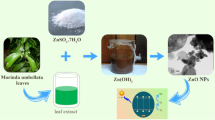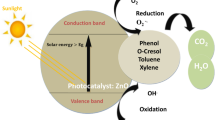Abstract
This paper investigates the elimination of two different organic dyes, m-toluidine and p-toluidine, utilizing the photocatalytic activity of Mg decorated ZnO nanoparticles that were biosynthesized using a biomass (Portulaca oleracea plant extract). The chemical and physical characteristics of Mg@ZnO nanoparticles were investigated using a variety of characterization techniques, including FTIR, UV, XRD, and SEM. Mg@ZnO nanoparticles organic dyes removal was then compared with pure ZnO nanoparticles. The characterization results have confirmed the biosynthesis of Mg@ZnO nanoparticles with a crystallite size ranged between 22 and 21 nm and band gap of 2.64 eV. The photocatalytic activity results have shown a significant organic dyes removal, where 100% of both m-toluidine and p-toluidine were removed within 60 min. The obtained results prove Mg@ZnO nanoparticles efficiency and its potential use as cost effective and safe alternative for water treatment.







Similar content being viewed by others
Data availability
Data sharing not applicable to this article as no datasets were generated or analyzed during the current study.
References
Daniel MC, Astruc D (2004) Gold nanoparticles: assembly, supramolecular chemistry, quantum-size-related properties, and applications toward biology, catalysis, and nanotechnology. Chem Rev 104(1)293–346. https://doi.org/10.1021/cr030698+
Jacinto MJ, Silva VC, Valladão DMS, Souto RS (2021) Biosynthesis of magnetic iron oxide nanoparticles: a review. Biotechnol Lett 43(1):1–12. https://doi.org/10.1007/s10529-020-03047-0
Rui M et al (2016) Iron oxide nanoparticles as a potential iron fertilizer for peanut (Arachis hypogaea). Front Plant Sci 2016(7):815–825. https://doi.org/10.3389/fpls.2016.00815
Ealias AM, Saravanakumar MP (2017) A review on the classification, characterisation, synthesis of nanoparticles and their application. IOP Conf Ser Mater Sci Eng 263(3):032019. https://doi.org/10.1088/1757-899X/263/3/032019
Ganesh K, Archana D (2015) Review article on nanoparticles : an overview, Am. J. Adv. Drug Deliv 3(3):196–215. Available: www.ojadd.com
Igwegbe CA et al (2019) Modeling of adsorption of methylene blue dye on Ho-CaWO4 nanoparticles using response surface methodology (RSM) and artificial neural network (ANN) techniques. MethodsX 6:1779–1797. https://doi.org/10.1016/j.mex.2019.07.016
Berechet MD, Stelescu MD, Manaila E, Craciun G (2015) Chemical composition of the essential oil of Artemisia absinthium from Romania. Rev Chim 66(11):1814–1818
Cao J, Wu Y, ** Y, Yilihan P, Huang W (2014) Response surface methodology approach for optimization of the removal of chromium(VI) by NH2-MCM-41. J Taiwan Inst Chem Eng 45(3):860–868. https://doi.org/10.1016/j.jtice.2013.09.011
Baig N, Kammakakam I, Falath W, Kammakakam I (2021) Nanomaterials: a review of synthesis methods, properties, recent progress, and challenges. Mater Adv 2(6):1821–1871. https://doi.org/10.1039/d0ma00807a
Hamdy MS et al (2021) Novel Mg@ZnO nanoparticles synthesized by facile one-step combustion route for anti-microbial, cytotoxicity and photocatalysis applications. J Nanostructure Chem 11(1):147–163. https://doi.org/10.1007/s40097-020-00355-9
Turan V et al (2018) Alleviation of nickel toxicity and an improvement in zinc bioavailability in sunflower seed with chitosan and biochar application in pH adjusted nickel contaminated soil. Arch Agron Soil Sci 64(8):1053–1067. https://doi.org/10.1080/03650340.2017.1410542
Tauqeer HM, Turan V, Farhad M, Iqbal M (2022) Sustainable agriculture and plant production by virtue of biochar in the era of climate change BT - managing plant production under changing environment. In: Hasanuzzaman M, Ahammed GJ, Nahar K (Eds). Singapore: Springer Nature Singapore, pp. 21–42
Ju-Nam Y, Lead JR (2008) Manufactured nanoparticles: an overview of their chemistry, interactions and potential environmental implications. Sci Total Environ 400(1–3):396–414. https://doi.org/10.1016/j.scitotenv.2008.06.042
Xu P et al (2012) Use of iron oxide nanomaterials in wastewater treatment: a review. Sci Total Environ 424:1–10. https://doi.org/10.1016/j.scitotenv.2012.02.023
Gurgur E, Oluyamo SS, Adetuyi AO, Omotunde OI, Okoronkwo AE (2020) Green synthesis of zinc oxide nanoparticles and zinc oxide–silver, zinc oxide–copper nanocomposites using Bridelia ferruginea as biotemplate. SN Appl Sci 2(5):911. https://doi.org/10.1007/s42452-020-2269-3
Kayani ZN, Saleemi F, Batool I (2015) Effect of calcination temperature on the properties of ZnO nanoparticles. Appl Phys A 119(2):713–720. https://doi.org/10.1007/s00339-015-9019-1
Suresh D, Nethravathi PC, Udayabhanu PC, Rajanaika H, Nagabhushana H, Sharma SC (2015) Green synthesis of multifunctional zinc oxide (ZnO) nanoparticles using Cassia fistula plant extract and their photodegradative, antioxidant and antibacterial activities. Mater Sci Semicond Process 31(March):446–454. https://doi.org/10.1016/j.mssp.2014.12.023
Okeke IS, Agwu KK, Ubachukwu AA, Maaza M, Ezema FI (2020) Impact of Cu do** on ZnO nanoparticles phyto-chemically synthesized for improved antibacterial and photocatalytic activities. J Nanoparticle Res 22(9):272. https://doi.org/10.1007/s11051-020-04996-3
Nwanya AC et al (2019) Industrial textile effluent treatment and antibacterial effectiveness of Zea mays L. Dry husk mediated bio-synthesized copper oxide nanoparticles. J Hazard Mater 375:281–289. https://doi.org/10.1016/j.jhazmat.2019.05.004
Okeke IS, Agwu KK, Ubachukwu AA, Ezema FI (2022) Influence of transition metal do** on physiochemical and antibacterial properties of ZnONanoparticles: a review. Appl Surf Sci Adv 8:100227. https://doi.org/10.1016/j.apsadv.2022.100227
Nwankwo U, Bucher R, Ekwealor ABC, Khamlich S, Maaza M, Ezema FI (2019) Synthesis and characterizations of rutile-TiO2 nanoparticles derived from chitin for potential photocatalytic applications. Vacuum 161:49–54. https://doi.org/10.1016/j.vacuum.2018.12.011
Okeke IS et al (2021) Impact of particle size and surface defects on antibacterial and photocatalytic activities of undoped and Mg-doped ZnO nanoparticles, biosynthesized using one-step simple process. Vacuum 187:110110. https://doi.org/10.1016/j.vacuum.2021.110110
Ebrahimi R et al (2019) Effects of do** zinc oxide nanoparticles with transition metals (Ag, Cu, Mn) on photocatalytic degradation of Direct Blue 15 dye under UV and visible light irradiation. J Environ Heal Sci Eng 17(1):479–492. https://doi.org/10.1007/s40201-019-00366-x
Khalid NR et al (2019) Enhanced photocatalytic activity of Al and Fe co-doped ZnO nanorods for methylene blue degradation. Ceram Int 45(17):21430–21435
Wang J, Zhou Q, Zeng W (2019) Competitive adsorption of SF6 decompositions on Ni-doped ZnO (100) surface: computational and experimental study. Appl Surf Sci 479:185–197
Pathak TK, Kroon RE, Swart HC (2018) Photocatalytic and biological applications of Ag and Au doped ZnO nanomaterial synthesized by combustion. Vacuum 157:508–513
Chen X, **. Ceram Int 46(2):2309–2316
Belkhaoui C, Mzabi N, Smaoui H, Daniel P (2019) Enhancing the structural, optical and electrical properties of ZnO nanopowders through (Al+ Mn) do**. Results Phys 12:1686–1696
Laouini SE et al (2021) Green synthesized of Ag/Ag2O nanoparticles using aqueous leaves extracts of Phoenix dactylifera L. and their azo dye photodegradation. Membranes 11(7). https://doi.org/10.3390/membranes11070468
Louafi O, Khelef A, Zeroual S, Laouini SE, Tedjani ML (2021) Effect of nickel nitrate concentration on the size of nickel oxide nanoparticles bio-synthesized by artemisia herba-alba aqueous leaves extract and improving their antioxidant activities. J Inorg Organomet Polym Mater. https://doi.org/10.1007/s10904-021-02152-5
Belaiche Y, Khelef A, Laouini SE, Bouafia A, Tedjani ML, Barhoum A (2021) Green synthesis and characterization of silver/silver oxide nanoparticles using aqueous leaves extract of Artemisia Herba-Alba as reducing and cap** agents. Rev Rom Mater 51(3):342–352. Available: https://www.proquest.com/openview/b1e4f32b093089d2c9d78d7b7b0a39cd/1?pq-origsite=gscholar&cbl=1216365
Meneceur S et al (2022) Photocatalytic activity of iron oxide nanoparticles synthesized by different plant extracts for the degradation of diazo dyes Evans blue and Congo red. Biomass Convers Biorefinery :1–16
Laid TM, Abdelhamid K, Eddine LS, Abderrhmane B (2020) Optimizing the biosynthesis parameters of iron oxide nanoparticles using central composite design. J Mol Struct :129497. https://doi.org/10.1016/j.molstruc.2020.129497
Bouafia A, Laouini SE, Tedjani ML, Ali GAM, Barhoum A (2021) Green biosynthesis and physicochemical characterization of Fe3O4 nanoparticles using Punica granatum L. fruit peel extract for optoelectronic applications. Text Res J :00405175211006671. https://doi.org/10.1177/00405175211006671
Bouafia A, Laouini SE, Khelef A, Tedjani ML, Guemari F (2020) Effect of ferric chloride concentration on the type of magnetite (Fe3O4) nanoparticles biosynthesized by aqueous leaves extract of artemisia and assessment of their antioxidant activities. J Clust Sci. https://doi.org/10.1007/s10876-020-01868-7
Bouafia A, Laouini SE, Khelef A, Tedjani ML, Guemari F (2020) Effect of ferric chloride concentration on the type of magnetite (Fe3O4) nanoparticles biosynthesized by aqueous leaves extract of artemisia and assessment of their antioxidant activities, J Clust Sci :1–9. https://doi.org/10.1007/s10876-020-01868-7
Laouini SE, Bouafia A, Tedjani ML (2021) Catalytic activity for dye degradation and characterization of silver/silver oxide nanoparticles green synthesized by aqueous leaves extract of Phoenix Dactylifera L. Res Sq :1–26
Mukherjee S, Nethi SK (2019) Biological synthesis of nanoparticles using bacteria. In: Nanotechnology for Agriculture: Advances for Sustainable Agriculture. Singapore: Springer Singapore, 2019, pp. 37–51
Tedjani ML, Khelef A, Laouini SE, Bouafia A, Albalawi N (2022) Optimizing the antibacterial activity of iron oxide nanoparticles using central composite design. J Inorg Organomet Polym Mater. https://doi.org/10.1007/s10904-022-02367-0
Freund F (1974) Ceramics and thermal transformations of minerals
Khajuria S, Sanotra S, Ladol J, Sheikh HN (2015) Synthesis, characterization and optical properties of cobalt and lanthanide doped CdS nanoparticles. J Mater Sci Mater Electron 26(9):7073–7080
Manjari G, Saran S, Radhakrishanan S, Rameshkumar P, Pandikumar A, Devipriya SP (2020) Facile green synthesis of Ag–Cu decorated ZnO nanocomposite for effective removal of toxic organic compounds and an efficient detection of nitrite ions. J Environ Manage 262:110282
Funding
The authors declare that no funds, grants, or other support were received during the preparation of this manuscript.
Author information
Authors and Affiliations
Contributions
Barani Djamel: writing the original manuscript and results discussion. Tedjani Mohammed Laid: results interpretation and discussion, online submission, article writing, and revising. Younes Zidane: data collection, preforming the experiments. Meneceur Souhaila: supervision and revising. Laouini Salah Eddine: supervision and revising. Hammami Hadia: reviewing and revising. All authors read and approved the final manuscript.
Corresponding author
Ethics declarations
Ethics approval
Not applicable.
Competing interests
The authors declare that they have no competing interests.
Additional information
Publisher's note
Springer Nature remains neutral with regard to jurisdictional claims in published maps and institutional affiliations.
Rights and permissions
Springer Nature or its licensor (e.g. a society or other partner) holds exclusive rights to this article under a publishing agreement with the author(s) or other rightsholder(s); author self-archiving of the accepted manuscript version of this article is solely governed by the terms of such publishing agreement and applicable law.
About this article
Cite this article
Barani, D., Tedjani, M.L., Younes, Z. et al. Biomass-mediated synthesis of ZnO and Mg@ZnO nanoparticles for enhancing the degradation of m-toluidine and p-toluidine. Biomass Conv. Bioref. 13, 7311–7318 (2023). https://doi.org/10.1007/s13399-022-03411-2
Received:
Revised:
Accepted:
Published:
Issue Date:
DOI: https://doi.org/10.1007/s13399-022-03411-2




